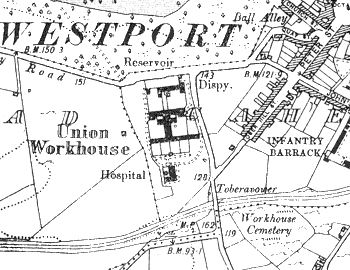Westport, Co. Mayo
Westport Poor Law Union was formed 20th July 1840 and occupied an area of 533 square miles. Its operation was overseen by an elected Board of Guardians, 26 in number, representing its 10 electoral divisions as listed below (figures in brackets indicate numbers of Guardians if more than one):
Co. Mayo: Achil (2), Aughagower (4), Ballycray, Clare Island (2), Clogher, Kilmaclasser, Kilmeena (3), Louisburgh (3), Newport (4), Westport (5).
The Board also included 8 ex officio Guardians, making a total of 34. The Guardians met each week on Thursday at 11am.
The population falling within the Union at the 1831 census had been 77,512 with divisions ranging in size from Ballycray (population 2,925) to Westport itself (15,315).
The new workhouse, built in 1840-42, occupied a 7-acre site on the southern side of Quay Road at the west of the town. It was designed to accommodate up to 1,000 inmates. Its construction cost £7,800 plus £2,000 for fixtures and fittings etc. Its location and layout can be seen on an early Ordnance Survey map:

Westport workhouse site.
The buildings followed Wilkinson's typical layout. An entrance and administrative block at the north contained a porter's room and waiting room at the centre with the Guardians' board room on the first floor above. This was later extended at the east with the addition of a wing containing children's school rooms and dormitories,
The main accommodation block housed the Master's quarters at the centre, and male and female wings to each side. At the rear, a range of single-storey utility rooms such as bakehouse and washhouse connected through to the infirmary and idiots' wards via a central spine containing the chapel and dining-hall. A separate hospital block was subsequently erected at the south of the site. The workhouse had its own cemetery a little way to the south-east of the site.
The new building was declared fit for the admission of paupers on 15th November 1842 but did not open due to a lack of operating funds. For two years, the Guardians attempted to collect the poor rate, sometimes with the help of police and troops. Eventually, in 1844, a warship and two cruisers sailed into Clew Bay to assist — without success. The Board of Guardians resigned and a new Board was elected. The workhouse was opened only after they were served a court order and finally admitted its first inmates on 5th November 1845. In 1847, continuing financial problems almost resulted in the workhouse having to turn out its 600 inmates.
The 1848 record-book of the Westport workhouse, recently donated to the Westport Historical Society by a library in England, records the weekly numbers of the dead and discharged, together with purchases of provisions and other day-to-day information. For example, on November 25th there were 1000 people in the workhouse, 30 in the fever sheds, 112 in the workhouse infirmary, and a further 700 living in an auxiliary workhouse. Supplies purchased during that week comprised 550 lbs of white bread, 12,000 lbs of brown bread, 50 oz of Butter, 4,300 gallons of butter-milk, 800 gallons of milk, 2 lbs salt, 77 lbs meat, 3½ lbs of Tea, 12 lbs Sugar, 280 lbs Molasses, 60 lbs Candles, 70 lbs Soap, 3 lbs Starch and a large quantity of Indian Meal. The Medical Officer had reported that both his nurse and acting nurse were both confined to bed by illness and he was then instructed to 'select two intelligent paupers' from the workhouse to perform the nurses' duties until they recovered. The Medical Officer was also having to deal with an outbreak of dysentery among the children.
At the 1901 census, the population of the Union was 34,672. In 1905, it was reported that there were 153 inmates in the workhouse.
The former Westport workhouse site is now occupied by a housing estate, although traces of the workhouse cemetery remain.
Staff
In 1905, workhouse staff were as follows:
- Master - Peter A Lennon
- Matron - Celia O'Malley
- Chaplains - Rev. James Owen Hannay (COI), Rev. Michael McDonald (RC)
- Medical Attendant - Anthony Gill
- Schoolmaster - William Connell
- Schoolmaster - Margaret Lennon
Records
Note: many repositories impose a closure period of up to 100 years for records identifying individuals. Before travelling a long distance, always check that the records you want to consult will be available.
- Local History Department, Castlebar Central Library, Castlebar, Co Mayo.
- London School of Economics Library, Archives Division, Lionel Robbins Building, 10 Portugal Street, London WC2A 2HD. Holds Board of Guardians minute book 1840-46.
Bibliography
- The Workhouses of Ireland by John O'Connor (Anvil Books, 1995)
- The Famine in Mayo 1845-1850 compiled and edited by Ivor Hamrock. Mayo County Council, 1998.
Links
- The Famine Years and their Aftermath - Westport Internet Group.
Unless otherwise indicated, this page () is copyright Peter Higginbotham. Contents may not be reproduced without permission.


